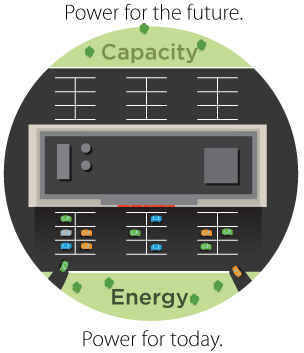Buying & Selling Energy
 |
| Think of capacity like a parking lot. A business’s lot needs enough spaces to accommodate customers at its busiest time (like Black Friday). This means many of the spaces may stay empty on a typical day, but the extra spaces are there for customers during a peak business time. |
Electricity is bought, sold and traded in wholesale and retail markets, similar to other commodities. PJM administers the competitive wholesale markets for large volumes of electricity across 13 states and the District of Columbia. From the PJM wholesale market, electricity is then sold in smaller quantities through retail electricity providers to end users, such as homes and businesses.
PJM uses several different wholesale market structures, including Energy, Capacity and Ancillary Services markets. All of the markets match electricity supply to electricity demand, but the objectives of each market differ in terms of timing and the specific system requirements they are trying to meet. To encourage competitive results, PJM ensures open, fair and equitable access for all who participate in its markets.
Some markets procure energy needed for today or tomorrow, while others ensure there will be enough resources in place to meet demand three years from now. Watch a video, How PJM’s Market Ensures Enough Power for the Future. Some markets aim to provide large volumes of electricity to meet demand while others incentivize small, incremental changes in the flow of energy to preserve system frequency - the “pulse rate” needed to allow all grid equipment to run normally. Regardless of the timing or objective, by matching supply and demand, all of PJM’s markets work together to create a wholesale price for electricity. You can learn more in a video: “What’s Behind Electricity Prices?”